Top News
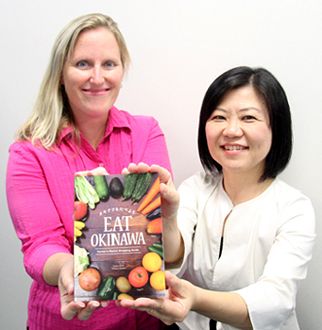
November 24, 2016 Ryukyu Shimpo
Okinawans are very well-acquainted with goya (bitter gourds), hechima (loofah gourds), handama (Okinawan spinach), and such Okinawan vegetables. However, when foreign people first encounter these, they notice many peculiarities in appearance and taste. Casey Annis and Chiharu Uehara from Ginowan City have now published a guide to help people unfamiliar with Okinawan vegetables called Eat Okinawa. The book introduces in English how to eat and where to buy Okinawan vegetables.
The inspiration for the book came from the Facebook page Annis started three years ago. Her page is intended for people affiliated with U.S. military bases and those from foreign countries. She posts information on farmer’s markets where one can buy vegetables fresh and cheap. As her page gained more followers, one after another she received questions and bewildered messages. She heard stories of surprise such as cutting open a winter melon mistaken for a watermelon, and biting into a goya that was thought to be a cucumber. Annis discussed these accounts with her friend of many years, Uehara, and after about two years they have completed this book.
In the book, ingredients are pictured with names listed in Japanese, phonetically in English lettering, and in English. It contains example recipes and recommendations on how to prepare ingredients, the locations of farmer’s markets and greengrocers in Okinawa, and simple Japanese phrases to use when shopping. There are many Japanese people buying the book as English teaching material. Annis and Uehara said their first priority was making the book easy to understand at a glance. They say that the one book covers every step from shopping for ingredients to up to eating.
The guide is being sold for 1,296 yen at four farmer’s markets in Okinawa: Hagoromo Ichiba (Ginowan City), Chatan Nirai Ichiba, Chanpuru Ichiba (Okinawa City), and Itoman Umanchu Ichiba.
Go to Japanese
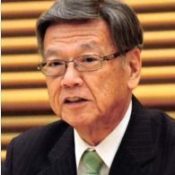
November 22, 2016 Ryukyu Shimpo
(Tokyo) At an assembly of nationwide governors on November 21, the first meeting of a study group established within the governors’ association with the aim of reducing the burden of U.S. bases on Okinawa was held at the Prefectural Assembly Hall in Tokyo’s Chiyoda Ward. At the meeting, Okinawa Governor Takeshi Onaga explained that it is a misunderstanding to think that U.S. bases bring economic and financial wealth, explaining that rather, the bases pose the greatest obstacle to economic development in Okinawa. Onaga explained that 18% of Okinawa Island is used for U.S. bases, and implored the other governors to imagine that 18% of their own prefecture were taken up by bases.
The study group consisted of eleven members, including Saitama Governor Kiyoshi Ueda, who served as chair of the meeting, Kyoto Governor Keiji Yamada, who is chair of the nationwide governors’ association, and Kanagawa Governor Yuji Kuroiwa, who is chair of a liaison council of governors with U.S. bases in their jurisdictions.
Ueda emphasized that as people responsible for their respective locales, the members must compile research results and points of issue, and must use the study meetings as a basis to raise their voices and bring up the issue in the nationwide governor’s association. Yamada said that he wants to see the base issue discussed as a common issue shared by all in the nationwide governors’ association.
Upon hearing Ueda’s remarks that the idea of the U.S. bases being the greatest obstacle to Okinawa’s economic development could apply to other areas as well, Onaga asserted that he felt the other governors had understood that bases are a burden for the locales in which they are located.
The study group will look at issues related to the U.S.-Japan security relationship, the Status of Forces Agreement, and base burden reduction. If the group is to provide recommendations to the national government, there will first be discussions among the nationwide governors’ association, and if its ideas are to be reflected in policy demands, there will be investigation into such matter among the nationwide governors’ association’s general standing committee and the abovementioned liaison council. The group plans to meet every two to three months, and the next meeting will be held between the end of January and the beginning of February, after President-Elect Trump of the United States takes office.
(English translation by T&CT and Sandi Aritza)
Go to Japanese

November 22, 2016 Ryukyu Shimpo
A press conference on a joint TV drama co-production between Okinawan and Vietnamese television broadcasting companies was held recently at the head office of Okinawa Family Mart in Naha City.
The drama aims to promote tourism, products and friendship between Okinawa and Vietnam.
The drama will be broadcast on Vietnam Television (VTV, the national television broadcaster of Vietnam) from the end of January to February 2017, on Ryukyu Asahi Broadcasting (QAB) in March.
It is a two hour-long love story, in which a reporter who works at a TV station in Okinawa meets a foreign student from Vietnam. And they fall in love. Karin Miyagi, a model and singer from Urasoe, Okinawa, plays the heroine, and Vietnamese Quang Sue plays the role of the lover.
Miyagi said, “This is challenging work being my first time as an actress. I want to buckle down and do the work with the feeling of being a member of the Okinawa national team.”
Go to Japanese
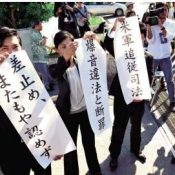
November 18, 2016 Ryukyu Shimpo
On November 17, the Okinawa branch of the Naha District Court, presided over by Judge Tetsuya Fujikura, issued a judgement in the second Futenma noise lawsuit. The lawsuit saw 3,417 residents living near U.S. Maine Corps Air Station (MCAS) Futenma demand a substantial ban on flights by U.S. military aircraft, which are the source of noise pollution, as well as compensation for both past and future damage resulting from the noise. Judge Fujikura assessed that “the [Japanese] government is not in a position where it is able to regulate or restrict flights by U.S. military aircraft at MCAS Futenma” and rejected the demand for a ban on flights using the same logic that has been used in previous lawsuits relating to noise from the bases, namely that the flights are an “act by a third party” that therefore cannot be controlled. The court rejected the argument that the agreement between the Japanese and U.S. governments for Japan to provide the Futenma base to the U.S. is unconstitutional and invalid on the grounds that the issue is not a matter to be deliberated on by the court. However, the court found that the harm suffered by the plaintiffs exceeds tolerable levels, and ordered the government to pay 2.46 billion yen for past damage. The plaintiffs intend to appeal the judgement.
The court ordered the government to pay 7,000 yen per month to residents experiencing a Weighted Equivalent Continuous Perceived Noise Level (W value) of 75 or more, and 13,000 yen per month to residents experiencing a W value of 80 or more per month. These amounts are each 1,000 yen more than the amounts ordered to be paid to residents experiencing the same W values in the first Futenma noise lawsuit, and are the highest of any amounts ordered to be paid in base-related noise lawsuits in Japan. The demand for compensation for future damages was dismissed.
Judge Fujikura indicated that the noise and low-frequency sound causes disruption of people’s daily lives, psychological distress, and sleep disruption. Although the court did not acknowledge an increase in the risk of ischemic heart disease or an increase in low birthweight rates, it acknowledged claims of health damage resulting from base-related noise in part, finding that there has been an increased risk of adverse health effects resulting from high blood pressure.
Although the court found that low-frequency sound is a cause of disruption of people’s daily lives, psychological distress, and sleep disruption, it said that there is not enough evidence to find that physiological effects and health effects are occurring. The court did not acknowledge any harm as a result of the Osprey aircraft, which were deployed after the lawsuit was filed, saying that there is not enough evidence to find that harm to the plaintiffs has increased.
Meanwhile, the court indicated that although more than four years have passed since the first Futenma noise lawsuit came to a close, there has not been any significant change in measures by the U.S. and Japanese governments to prevent damage, and assessed that the illegal damage being caused to nearby residents has been left undealt with.
The court did not acknowledge the claims of residents living outside the contour (distribution map) for noise pollution around the airfield, saying that damage suffered by such residents cannot be found to be of a degree as great as that suffered by those experiencing a W value of 75 or greater.
(English translation by T&CT and Sandi Aritza)
Go to Japanese

November 21, 2016 Ryukyu Shimpo
At noon on November 21, the All Okinawa Kaigi (All Okinawa Coalition) held a gathering in front of the Naha Branch of the Fukuoka High Court at Jogaku Park, demanding a neutral and fair trial from the Supreme Court. According to the organizers, 900 people participated in the gathering. National Diet members and members of organizations comprising the executive body of the All Okinawa Kaigi took the podium to convey their opposition to construction in Henoko, within and outside of Okinawa.
Mayor of Nago City and co-representative of the All Okinawa Kaigi Susumu Inamine claimed that the deliberations at the High Court were lacking. He hopes that the Supreme Court will adhere to a neutral and fair position during deliberations, and will make a decision that will go down in history. In addition to the lawsuit, he called for everyone to keep making their voices heard, to not give up, and to work hard until they see victory against base construction.
A gathering linked with the one in Naha was held on November 21 in front of the Supreme Court in Tokyo.
(English translation by T&CT and Erin Jones)
Go to Japanese
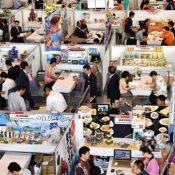
November 22, 2016 Ryukyu Shimpo
Japan’s largest international food industry expo, “The 3rd Great Okinawa Trade Fair” was held on November 21 in the Okinawa Convention Center in Ginowan. The Executive Committee of the trade fair hosted 188 suppliers from 41 different prefectures throughout Japan, as well as 73 suppliers from Okinawa, totaling 261 exhibiting companies. In addition, the trade fair also welcomed 201 buyers, both domestic and from 15 different countries including Singapore, Taiwan, and China. The 462 participating companies was the largest they have ever had.
Executive Committee Chairman Kunio Oroku (who also serves as the chairman of the Okinawa Konwakai) welcomed the participants at the opening ceremony, saying, “As we move from pre-convention to the expo itself, this will be the fourth convention. Many Okinawan and other Japanese goods have been able to develop in overseas markets through the Okinawa International Logistics Hub.”
At exhibition booths arranged throughout the convention hall, suppliers and buyers gathered from all over the world are expected to engage in over 3,000 exchanges through November 22, including individual and free business negotiations. Exhibitors also handed out samples, eagerly looking to sell their best products. The exhibition hall also hosted “Jetro Foodex in Okinawa” and “Japan Sweets Selection 2016.”
Go to Japanese
November 17, 2016 Ryukyu Shimpo
On November 16, the Okinawa Prefectural Government (OPG) submitted a written statement of opinion to the Okinawa Defense Bureau (ODB) regarding the plans for returning more than half of the Northern Training Area (NTA) back to Higashi and Kunigami Villages. The statement involved 33 demands, such as the thorough removal of contaminated soil and unexploded bombs. It also calls for another Environmental Impact Assessment (EIA) specifically on the U.S. Marine Corps transport aircraft MV-22 Osprey, in relation to the U.S. helicopter landing zone, or helipad, currently being built in the NTA. Moreover, one of the demands involves the withdrawal of Ospreys via an early reassignment to prefectures outside of Okinawa. For the OPG to mention the continued operations of U.S. bases while also discussing the plans to return the land back to Okinawa is unprecedented.
The written statement of opinion was dated November 15. It mentions the statement regarding the use of defoliants by ex-servicemen. Because of this, a representative of the OPG demands, “Defining ‘surrounding areas’ as much as possible and conducting a general investigation on dioxins.”
Another demand involves the swift submission of an investigative report compiling the flight training records from the U.S. military and interviews with ex-workers of the military.
The land reclamation plan does not specify how to determine the area of contamination or how to remove the contamination. Because of this, the representative demands, “Upon investigating the contamination status of the soil and water, a concrete investigation must be conducted, along with measures to remove possible obstacles. The plans must be adjusted after consulting the OPG etc. Only then can [the plan] be executed.”
The land that is planned to be returned includes a drainage basin, such as the Fukuji Dam. Because of this, the representative demands, “If detected, appropriate measures must be taken to remove the contamination, and to avoid affecting the soil and water quality of the surrounding areas into the future.”
After receiving the written statement of opinion from the OPG, along with Higashi and Kunigami Villages, the ODB is to notify the OPG etc. after they have come up with a land reclamation plan. At earliest, it will be handed over to the land owners by December 2017.
Outline of the governor’s opinion
•Thorough removal of contaminated soil and unexploded bombs before returning land.
•Submit report compiling the records on land use and interviews with those involved.
•Conduct a general investigation on dioxins based on interviews.
•Avoid affecting soil and water quality of the surrounding areas of the dam and drainage basin.
•It will be the country’s responsibility to take care of any unexploded bombs or buried waste discovered after the land has been returned.
•Conduct another Environmental Impact Assessment (EIA) specifically on Ospreys in relation to the helipad currently being built.
•Remove Ospreys.
(English translation by T&TC and Chelsea Ashimine)
Go to Japanese
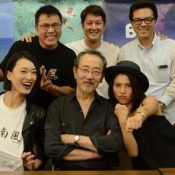
November 16, 2016 Ryukyu Shimpo
On November 5, filming kicked off for a romantic movie called “Jimami Tofu”, which has Ryukyuan food as its central theme. On November 14, Singaporean Jason Chan, one of the main characters and the film director, and an actor from Okinawa Masane Tsukayama held a press conference at the Okinawa Prefectural Government building. Chan said, “Eating Ryukyuan food made me feel comfortable and brought back memories. I hope this movie will help Ryukyuan foods become widely known in the world.”
Film shooting will take place for a month in Okinawa mainly in Kinjo-cho of Naha and in Nakijin. Besides Tsukayama, a dancer from Okinawa Rino Nakasone and actress from Tokyo Mari Yamamoto will appear in the film.
Fascinated by Ryukyuan food in Okinawa, a Singaporean chef, Ryan (Chan) asks an owner chef Sakumoto (Tsukayama) to teach him about Ryukyuan food. Ryan’s ex-girlfriend Yuki (Yamamoto) is a top Japanese food critique and a daughter of Sakumoto. Yuki’s friend Nami (Nakasone) introduces him to Sakumoto and falls for Ryan while spending time with him.
Tsukayama says, “This film looks at the history and the trading relationship of Ryukyu from a foreign perspective. This film makes us think about the heart of Okinawa.” Nakasone said with a smile, “Although I am Uchinanchu, I learned the good things about Okinawa again through this film.”
The film is the first Singaporean film to be subsidized by the Okinawa Convention & Visitors Bureau and the Prefecture’s Film Tourism Promotion Project. The film will be screened in Singapore next February. From March, the film will be available onboard 93 flights between Naha and Hong Kong, and Naha and Taiwan. The screening in Okinawa is still in the process of being scheduled.
(English translation by T&CT and Megumi Chibana)
Go to Japanese
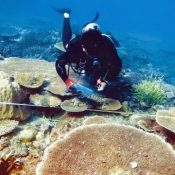
November 17, 2016 Ryukyu Shimpo
A group named “The Association for Fishers who Protect and Harness Beautiful Sea” conducted a survey on the coral reef in Oura Bay, Nago City, on November 16. The group consists of those who are involved in fishery and are against the construction of the Henoko base. Together with the director of the National Conservation Society of Japan, Mariko Abe, the group conducted a reef check to monitor the condition of the coral in Oura Bay. Although coral bleaching was observed all over the area, the coral was deemed to be in “healthy” condition.
At one of the survey points called “chiribishi”, staghorn coral was almost completely damaged due to El Nino in 1998. It was observed as recovering in January this year. Five percent of the coral were observed as dead due to high water temperatures during the summer. The first part of cover degree in the survey was down by 6.2 points from the previous survey to 41.3 percent with the latter part up by 1.2 points to 10 percent.
At the other three survey points, there were approximately three to seven points of increase/decrease, yet no severe damage was found. “There are cases around the world where severe coral bleaching happens for three consecutive years during summer. There is also the potential for Okinawa to have such damage due to the bleaching after next year,” Director Abe comments.
The association will conduct reef checks around the prefecture until November 23.
(English translation by T&CT and Sayaka Sakuma)
Go to Japanese

November 16, 2016 Ryukyu Shimpo
One-year-old Himari Morikawa traveled to the United States to undergo a cardiac transplantation and the operation was successfully carried out on November 14. Head of “Save Himari Association,” Narimasa Tsuha, said, “We managed to be successful thanks to you. We are full of gratitude to all the people who supported Himari.”
Tsuha said the father of Himari, Koki Morikawa, informed him of the successful operation via phone. He added that the condition still requires caution; however, the family believes in miracles, and continues to push on.
Two-year-old Noa Onaga underwent a cardiac transplantation with donated funds this February and her operation was successful. A surplus of the funds was donated to the transplant expenses of Himari. Noa’s father Tsukasa Onaga said, “I am glad to hear the news. Although the parents of Himari are still concerned about dealing with the possibility of an adverse reaction and a course of physiotherapy, they need to get some rest because the operation was successful.”
On the Facebook page of “Save Himari Association,” people wrote that they are relieved, glad she made it and wanted to see her smile.
(English translation by T&CT)
Go to Japanese
November 18, 2016 Ryukyu Shimpo
The Okinawa Defense Bureau (ODB) has made an external informational document publicizing photographs of the citizens opposed to the construction of helipads who have entered land provided to the U.S. military. The distributed document judges the citizens’ behavior as “heinously illegal acts.” A lawyer commented that would be possible for the ODB to indicate damages to the police and request an investigation into the matter. However, the lawyer went on to say that the ODB has gone too far by widely supplying such information at a time when there is general inquiry concerning these citizens’ actions.
It seems the ODB’s appreciation of human rights has been thrown into doubt, due to its description of certain individuals’ behavior as “heinous and illegal,” and its spreading of content capable of fostering prejudice against citizens’ campaigns opposing the overlarge share of the base burden on Okinawa.
This document explains that local citizens are the ones causing the destruction of precious vegetation and having devastating effects on the environment. The ODB stated that its reasons for making these materials were to explain the present condition of these matters, and to respond to many inquiries it receives concerning the activities of those persons opposing construction related to relocation. On the other hand, an environmental expert stated that the burden on the environment is being caused in the same places that ODB personnel, riot police, and security personnel are dispatched. This expert also explained that the construction of helipads is the actual cause of large-scale deforestation and destruction of nature.
The document was no less than nine pages long and included an attachment called “Illegal Trespassers,” which presented many photographs of citizens who engage in protest activities. Another item titled “Examples of Illegal and Heinously Disruptive Behavior” held nine photographs of Chairman Hiroji Yamashiro of the Okinawa Peace Movement Center entering land provided to the U.S. military.
On the page titled “Interferences to Environmental Conservation Measures,” the ODB explained that windbreak fencing and transplanted Ryukyu-chiku (a variety of bamboo found in Okinawa) will be put around the helipads as an environmental conservation plan to protect against direct wind and sunlight, as well as soil runoff. Without addressing the large-scale deforestation related to construction, the document indicates that the citizens who protest in the Northern Training Area are trampling down the environs surrounding the transplanted Ryukyu-chiku. When asked by the media, the ODB responded that it is also using the document as needed when external explanation is necessary.
(English translation by T&CT and Erin Jones)
Go to Japanese









 Webcam(Kokusai Street)
Webcam(Kokusai Street)


